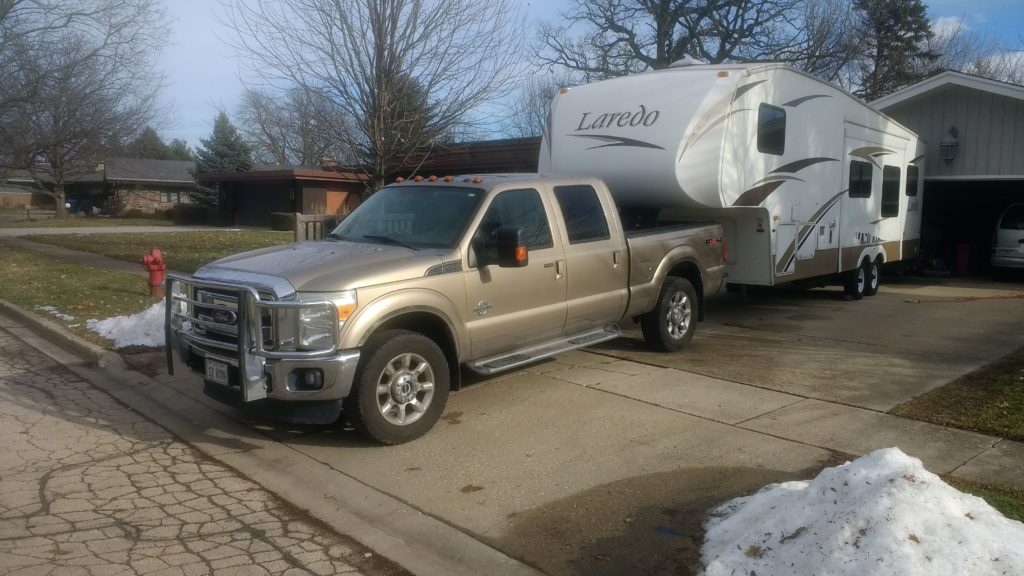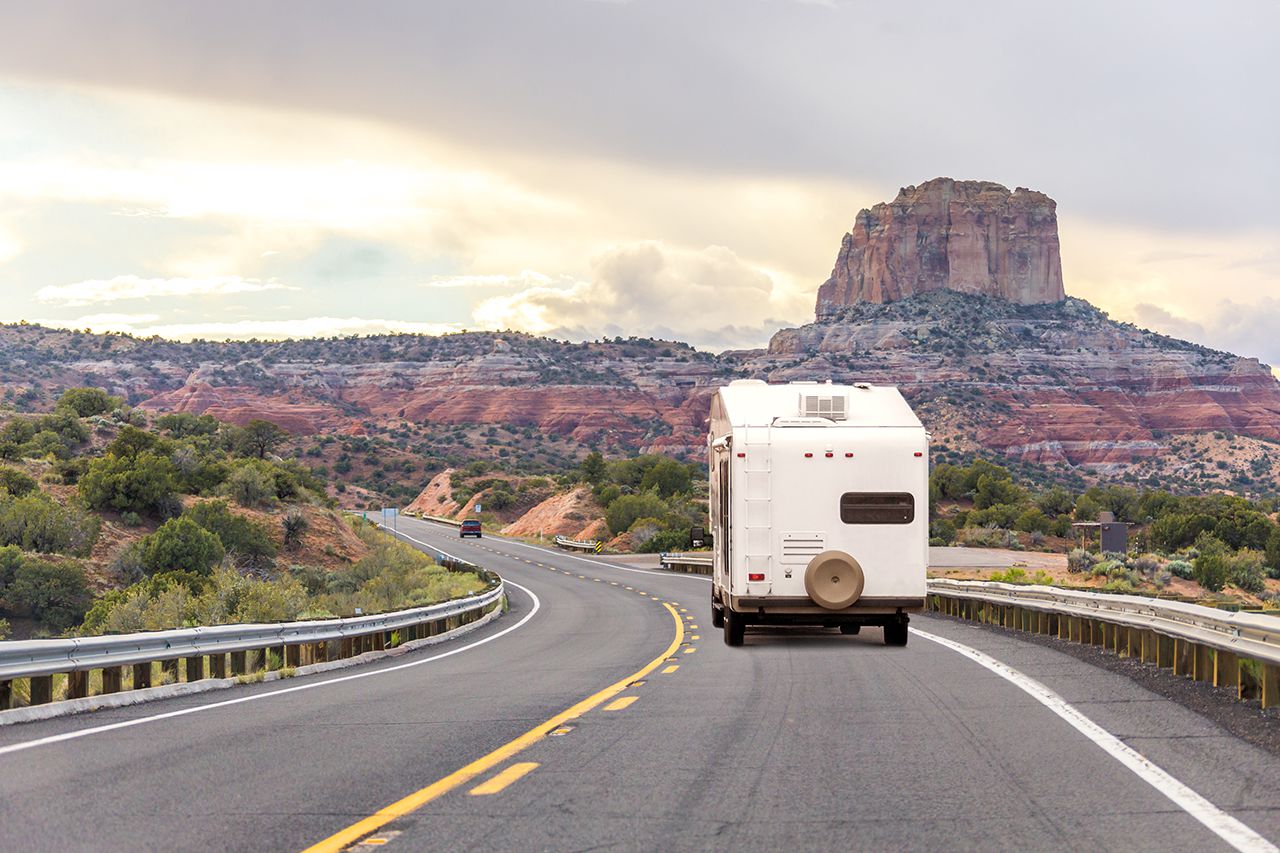
I’ll never forget the morning after our second night of RVing. It was probably 11:00am. I was outside unhooking the water and getting ready to hitch up the truck when a friendly park staff member started up a conversation with me during a break from raking leaves.
“You’re getting ready to leave now?” He said, in disbelief. “I’d be getting set up at my new place by now, if I were you.”
It was my first glimpse into RV Travel Rules that many hold to be gospel.
We obviously had a reason for leaving when we did. At that time, Adelaide napped around 11:00am; so leaving during her nap rather than before or after made the drive a lot easier.
Since then, we’ve seen first-hand the myriad of rules that folks use when traveling in their RV. We’ve developed a set of our own and will give a brief overview of the common ones (and ours) here.

Why are there RV Travel Rules?
RV travel is far different from traveling in a car. Driving for 8-10 hours in a car isn’t that big of a feat. I’ve done it many times. But driving with (or in) and RV is exhausting. Lane changes are hard. You need lots of clearance. Any semi-truck you pass or that passes you is felt. There’s a “sucking” feeling when a semi approaches and passes. Exits and on-ramps are serious events in an RV and just a minor inconvenience in a car. Getting fuel is stressful – will I hit the top? Will I swipe the pump when I pull out? Can I even get in or out of the station?
Then, there’s the set-up and tear-down of a campsite. You need to level the rig, possibly un-hitch the truck, plug into electrical, hook up water, put out the slide-out. Then do it all again in reverse the next morning to leave. It’s not just hop in and go. Doing this in the dark of morning or night isn’t very fun.
Thus, people have developed rules to aid in the headaches and avoid driving too far. There are a few widely followed/known rules, a few we’ve heard anecdotally that aren’t as “formal”, and the set we’ve developed for ourselves.
2-2-2 RULE:
The 2-2-2 Rule is simple. Drive less than 200 miles, arrive to camp by 2:00pm, and stay 2 nights. 2-2-2. With this rule, you’ll leave in the mid-morning. Have a leisurely drive with ample time for fuel or lunch, then arrive just after check-in time to set up in the sunlight and be able to explore the area in the afternoon. It’s a relaxing way to travel, for sure. You won’t get very far following the rule, and for people without unlimited time on the road, that’s the killer. Staying 2 nights at some random place!? That seems unreal to us. Nonetheless, the rule is popular and widely followed by the full-time RV community.
3/300 RULE:
Like the 2-2-2 Rule, the 3/300 Rule limits distance and arrival time. The rule says to arrive no later than 3:00pm after driving no more than 300 miles. Notice that arriving in the afternoon is popular! Driving 300 miles at 60mph is 5 hours of driving. Thus, one could leave at the reasonable time of 9:00am, drive for a few hours, get lunch/fuel, then drive some more to arrive by 3:00pm. There is no minimum number of nights with this rule. It’s a reasonable rule purely focused on travel and travel safety, but is missing a number of nights aspect, in my opinion.
ASAP Rule:
The final rule we’ve observed is the “ASAP Rule”. Our neighbor at Sun-N-Fun last year drove there in one shot from Michigan . 20 hours! He’s the extreme of the rule (and definitely unsafe). The safer version of the rule is to drive until late evening/night. There are many RVs that pull in after our kids have gone to sleep. Being woken up the rumble of a big engine as the sun is rising isn’t foreign. So these folks literally wake up with the sun, drive as long as they feel safe (slightly into the darkness), get some sleep, then do it again until they reach their destination. It’s the way to maximize time at a destination. Our kids can’t take that much time in the car yet. And traveling this way misses out on some of the fun of experiencing a new town/RV park, even if just for a night.
OUR RULE: The 4-4-4 RULE

We developed some rules of our own as we traveled. They pretty cleanly fit within the same nomenclature as the 2-2-2 Rule, so we’ve adopted the name of The 4-4-4 Rule. The rule is to drive about 4 hours (according to Google Maps), arrive by 4:00pm, and stay NO MORE than 4 nights.
4 hours of driving according to Google Maps is 280 miles at 70mph. Because we drive slower, it winds up being 5-6 hours of actual driving time. This isn’t too far from the 300 mile limit of the 3/300 Rule. It’s a nice, safe, and far enough distance to be reasonable for most travelers. Our kids can do this amount of car time without too much complaining. We usually let them burn off some energy midway through at a rest stop playground or McDonald’s PlayPlace. They usually take a nap. And get some screen time as a last resort.
Arriving at a reasonable time is a staple of the 2-2-2 Rule and 3/300 Rule. Having light and not being too tired makes setting up much more pleasant. Also, if you need to make a grocery run, go out to dinner, or just enjoy the pool, arriving at a reasonable time is mandatory. Because we tend to take off between 10:00-11:00am after a hearty breakfast, arriving by 4:00pm after the 5-6 hours of driving is just how the math works. And there’s always plenty of light left to set up.
The final aspect of our rule, 4 as MAXIMUM number of nights, is how we prefer to travel. We spent 4 nights in just about all of our major stops on the 2nd half of our trip. We only spend one night as we’re traveling (until we get to our destination). But we’ve found 4 nights is the magic number of nights. It give you 3 FULL DAYS to explore and the half day upon arrival when you can relax, explore a bit, or enjoy amenities on the first night. Full Day 1 is then spent doing the big things. The Alamo in San Antonio or whatever else is the major draw of a place. Full Day 2 is then spent doing the other attractions of a place. Full Day 3 is either used to do more things, re-experience the favorites from Days 1 & 2, or relax and enjoy RV park amenities. 4 nights is great when you don’t know exactly what a place has to offer. It’s long enough to experience a place and become familiar but not so long that a dud stop makes you mad. It leaves you wanting to return to good places and know that the duds aren’t worth any more time.

CONCLUSION:
So those are the major RV travel rules we’ve encountered. We obviously like our 4-4-4 Rule best. Do you follow any RV travel rules? Is 4 nights enough? Too many? Do you rush to your destination or enjoy the journey?
